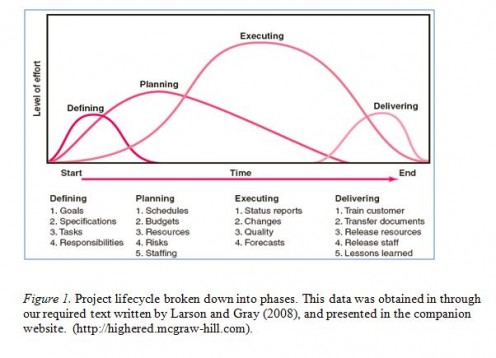Project Management: The Lead Role

The role of project manager is a very challenging position that requires a very skilled, resourceful, and determined individual. To excel in the career, this position requires a person who is able to lead, as well as, manage the team. A superior project manager desires maximum results and takes an active interest in the success of each team member. Some of the important factors of running a successful project include: planning and managing the project lifecycle, using critical thinking and team building skills, and taking the time to properly implement the work breakdown structure.
Project management in its entirety is "the body of knowledge concerned with the principles, techniques, and tools used in planning, control, monitoring, and review of projects" (BusinessDictionary.com). We separate projects from our normal everyday duties because usually they are a onetime ordeal that has a specific goal, a defined lifespan, as well as, time and budget constraints. To ensure a successful completion a project manager must be dedicated, organized, creative, and hardworking. The demand for knowledgeable project managers is in the rise due to the many costly changes and implementations in today's business world. Failed projects waste the organization's time and money, two things that are deeply important to most stakeholders. A successful and trained project manager is capable of saving the company extra time and money by planning, monitoring, and coaching the team throughout each stage of the project life cycle. The organization will begin to see increased profits, higher quality, and improved production times.
Every project has a beginning, and middle, and an end which is referred to as the project lifecycle (Figure 1). The beginning of the project would include the planning and defining stages of the project lifecycle. The middle point of the project is referred to as the execution portion of the project which is followed up with deliverance of the final results. The end of the project is where we present the finished project, however even after the delivery there is a process of monitoring the result and documenting what we have learned.


"Effective project management begins with selecting and prioritizing projects that support the firm's mission and strategy" (Larson and Gray, 2008). Once the project has been assigned or selected, the defining phase begins. The initiation of the project is where the organizational need is identified (Heerkens, 2008). This is the part where we are establishing our goals and mission for the project. "Once you've identified the true need, you need to expand upon it and fully quantify it" (Heerkens, 2008). The extensive planning should not begin until the stakeholder needs have been accessed, prioritized, and documented in what is known as the project requirements document (Heerkens, 2008). This document should provide key background information such as: goals, mission, values, constraints, strategic fit, as well as, other assumptions, supporting information, and uncertainties. All of this information will provide a tremendous assistance to all who are involved in the planning and execution of the project.
Preliminary planning is not extremely lengthy because it is based on estimates and ranges. However, before we take our plans to upper management we must have plotted every detail and dollar to a convincing level. We need to be able to show our superiors the potential success and profits that will come with the completion of our work. Once the approval is given, we dig even deeper into the costs and processes involved. During the planning stage it is important to break down the project step-by-step to determine resources needed, estimate cost and duration, spot potential risk, and create vital documentation that will communicate our research and planning to the entire team. Without researching the costs involved, the project is likely to go over budget. The planning phase prepares us for the realities of the project. A superior project manager uses his critical thinking skills to make adjustments throughout the course of the project which sometimes calls for innovative measures.
Leadership is a skill that is in most successful project managers. It is the ability guide the team to success by helping them reach their full potential. A good leader motivates and empowers the team. A great leader wants his team to shine because he knows that his success is their success. He sets a good example and demonstrates qualities of fairness and understanding. In many ways, a leader is similar to the project sponsor. In most large projects, an experienced leader from upper management acts as a sponsor throughout the project. It is important that the project manager and sponsor communicate often, especially at the completion of each phase of the project. This enables us to converse and make necessary changes based on his or her experience and recommendations. The sponsor's advice is usually a great assistance when it comes to meeting the goals and expectations of the company stakeholders.
Teambuilding is another vital tool when it comes to creating a successful team of individuals. In order to build a good rapport with the team, the manager must invest time to each individual. Communication is the key to a successful relationship with the team. The manager must be able to clearly communicate each individual’s role in the project, as well as, all expectations of the work involved. Teambuilding includes providing guidance and support as each team member is fulfilling their role in the project. One of the most popular techniques for teambuilding is managing by walking around (MBWA). "This approach allows you to see everything going on, and it allows you to listen directly to the employees. It is especially effective in an organization with many management layers. The approach permits all employees direct access to the boss and frequently generates high levels of spontaneous, creative synergy while employees and the boss exchange ideas" (www.businesstown.com).
When planning for an extensive project the creation of our work breakdown structure (WBS) will provide us with a solid understanding of the tasks that will be occurring during the project. By placing the tasks into groups we are able to create specific assignments and budgets for each unit or team of individuals. In most projects there are several events happening simultaneously to increase efficiency. "The WBS provides an easy-to-read graphical representation of the work, allowing stakeholders to review it thoroughly for missing elements of work" (Heerkens, 2008). Heerkens points out that, "people often underestimate the effort required to execute a project" (2008). Many people are able to get a better grasp on the projects size and duration by viewing a detailed work breakdown structure that has been properly formatted and shows the work broken down into work packages.
There are several tools that help project managers create and maintain a work breakdown structure and monitor the progressions of our project. Microsoft Project is a well known software that project managers use to manage their projects. In addition to the WBS we are able to analyze the projects progression and make decisions based on information that has been formatted in different ways designed to help us spot areas where changes may be needed. Microsoft project enables us to view the critical path schedules, updated budgets, workloads, as well as, a vast assortment of graphs and charts that awaken our critical thinking skills.
Project management is a career that can be used in any field. To be a successful project manager, a certain amount of skill has been acquired in our professional experience. Much thought and preparation is put into successful projects, and it is definitely an accomplishment when you can turn and look at what you have been able to lead your team to an exceptional finish. As we discussed, several of the important factors of running a successful project are: planning and managing the project lifecycle, using critical thinking and team building skills, as well as, taking the time to properly implement the work breakdown structure
A little humor to brighten your day !
References
Heerkens, Gary R. (2002). Manager's Guide to Project Management. McGraw-Hill Irwin. ISBN: 9780071379526.
Larson, E., & Gray, C. (2011). Project management: The managerial process (5th ed.). Boston: McGraw-Hill Irwin. ISBN: 9780077426927.
Larson and Gray (2008). Modern Project Management. Retrieved June 7, 2011 from http://highered.mcgraw-hill.com/sites/0073525154/student_view0/chapter1/.
Business Town.com. Managing People - Communication: Management by Walking Around. Retrieved June 13, 2011 from http://www.businesstown.com/people/communication- walking.asp
Project management. BusinessDictionary.com. Retrieved June 13, 2011, from BusinessDictionary.com website: http://www.businessdictionary.com/definition/project- management.html









